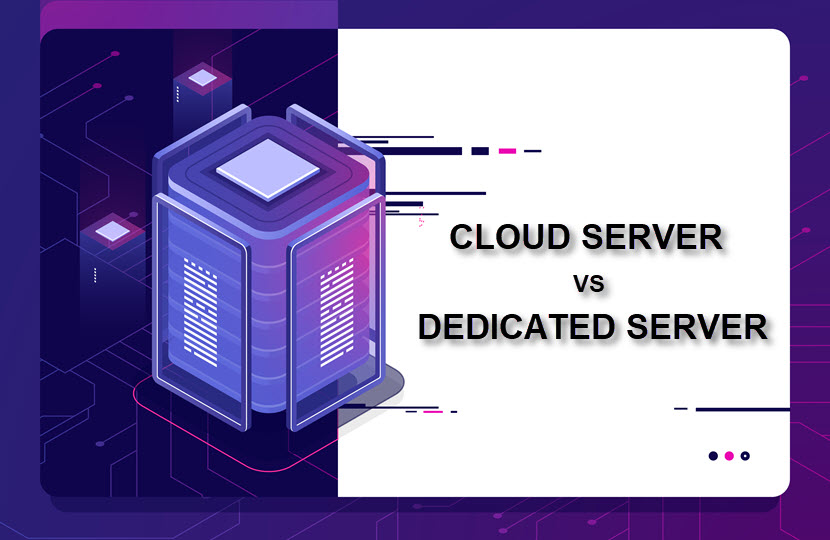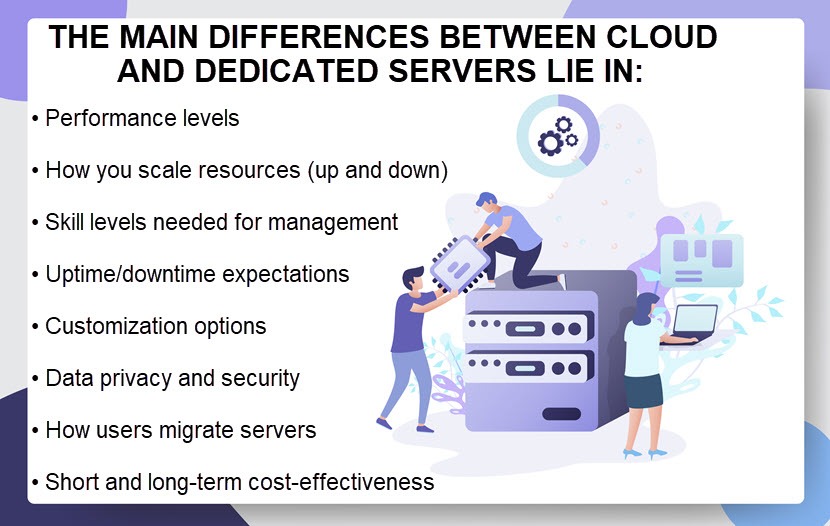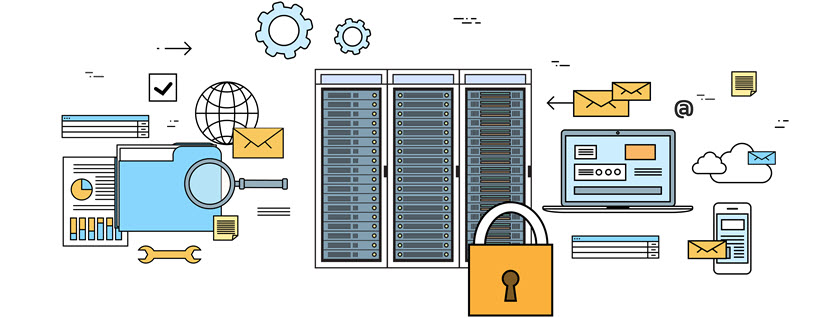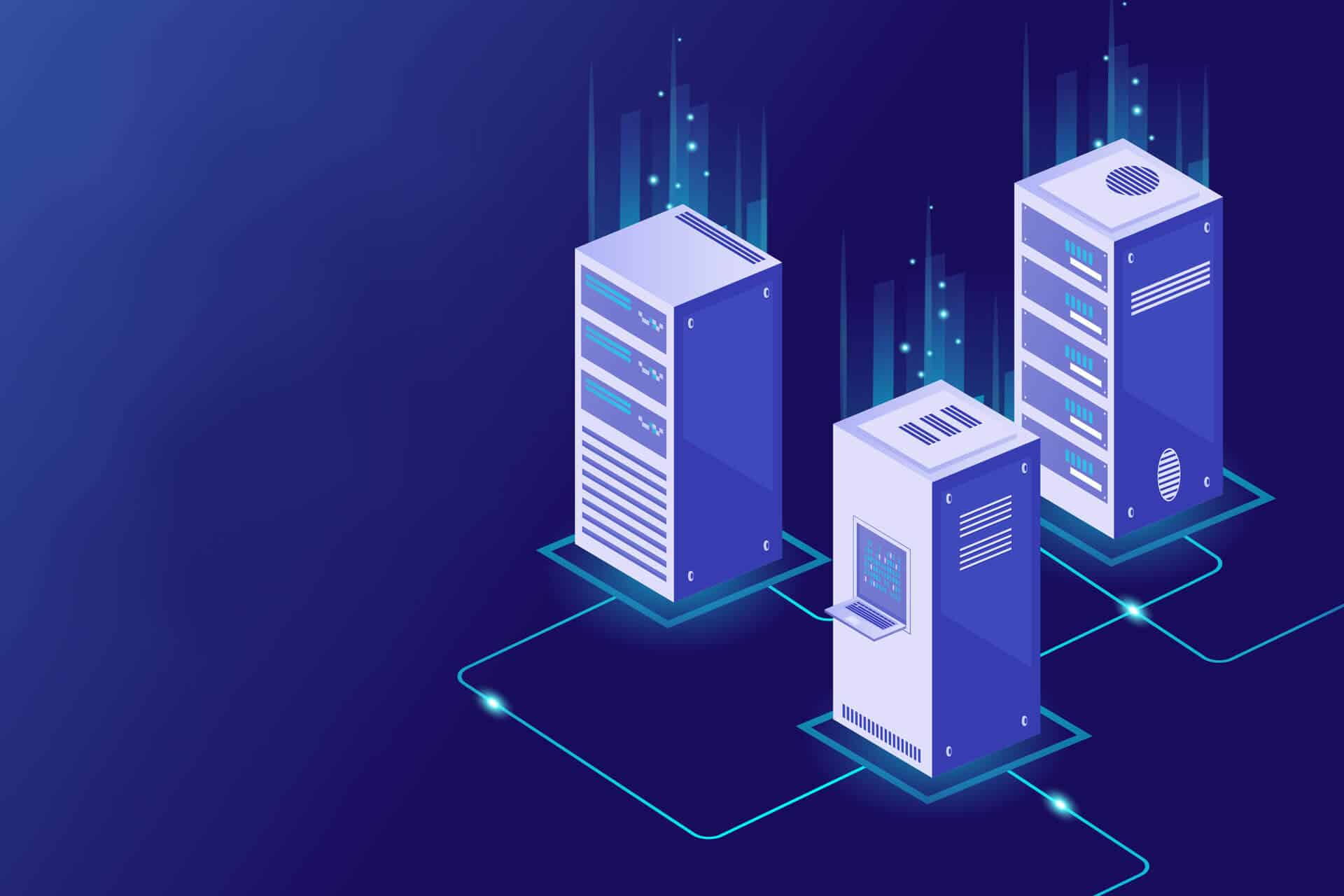Since even a one-second difference in page response time can cost you up to 7% of your customer base, choosing the correct hosting model is a vital business decision. Cloud and dedicated servers are two popular choices if you are looking for top-tier performance and uptime, but these hosting models excel at different use cases. Which one is the right option for your business needs?
This article explains the difference between cloud and dedicated servers and outlines the features of both hosting types. We provide all the info you need to make an informed decision and identify the hosting option that fits your use case, business needs, and budget.

Cloud vs Dedicated Server: Definitions
Before we examine the differences between cloud and dedicated servers, let us first look at the definitions and benefits of both hosting models.
Cloud Servers
A cloud server is a virtual server running in a cloud computing environment. These servers provide users with on-demand virtual resources and offer unrivaled scalability (both up and down).
Clients that rely on a cloud server do not need to buy or maintain any hardware. The cloud provider handles maintenance while users adjust virtual resources (processing, RAM, storage, etc.) to create an optimal configuration.
Cloud servers offer a range of business benefits, including:
- No initial hardware investments.
- Near-instant server deployments.
- A pay-as-you-go billing method.
- High redundancy.
Virtualization also leads to various orchestration and automation options, a trait especially helpful for agile and DevOps teams.
Dedicated Servers
A dedicated server is a physical device set up at a data center and used by a single client. Unlike a cloud server, these traditional setups do not use virtualization and rely on actual hardware (CPUs, GPUs, RAM, hard drives, network cards, etc.).
When you set up a dedicated server, the entire device is at your disposal. You do not share resources with other users, a feature that makes these servers both the safest and fastest hosting option on the market.
Some notable benefits of dedicated servers are:
- Complete freedom to customize the configuration (both hardware and software).
- Single tenancy guarantees top data privacy and security.
- High levels of uptime.
- Consistently fast loading times.
When setting up a dedicated server, you can either:
- Rent a server from a data center.
- Install privately-owned equipment at a third-party data center (colocation).
PhoenixNAP's colocation services enable you to set up your equipment in a top-tier facility and rely on various managed services that streamline everyday operations.
Similarities Between Cloud Server and Dedicated Server
Cloud and dedicated servers are common hosting choices for companies looking for high reliability and performance. While the two hosting models rely on different infrastructures, both server types perform the same basic functions as they can:
- Store data.
- Receive requests for the stored info.
- Process requests.
- Return data back to the user.
Both cloud and dedicated servers can support any service or app you want to host. The two server types also rely on similar backend tools. When compared to shared and VPS hosting, both cloud and dedicated servers can:
- Offer a more robust and customizable system architecture.
- Handle significantly more traffic.
- Provide faster response times.
- Ensure greater app resiliency.
If you know how to manage them correctly, both dedicated and cloud servers are excellent hosting choices. Neither model suffers from performance lags during traffic spikes, and both of them process data faster than a shared or VPS host.
Unsure whether your business is ready for dedicated hosting? Our in-depth comparison of shared and dedicated hosting helps evaluate the right infrastructure type for your use case.
Difference Between Cloud Server and Dedicated Server: Head-to-Head Comparison
The table below offers a high-level overview of the differences (and similarities) between a cloud and a dedicated server.
| POINT OF COMPARISON | CLOUD SERVER | DEDICATED SERVER |
| Type of infrastructure | Virtual servers with abstracted resources separated by a hypervisor | A physical device with dedicated hardware components |
| Main selling point | Clients can optimize IT performance without the costs of purchasing or managing a dedicated infrastructure | Create a fully custom server with resources dedicated solely to your use case |
| Single tenancy | No | Yes |
| Performance | High due to powerful bare metal servers, but can suffer from lag if there are too many tenants or processing requests | Consistently high performance thanks to dedicated hardware |
| Scalability | Near-instant scaling that can quickly accommodate traffic surges | Users must set up new hardware when looking to scale up (if there are available slots or bays) and take the hardware out when scaling down |
| Automatic scalability | Yes | No |
| Deployment time | The server is up and running seconds after you configure the unit | Longer deployment times |
| Root access | Depends (no root access if hosting on a public cloud) | Yes |
| User/role administration | Yes | Yes |
| Customization | Limited hardware and software customization as providers offer only predefined packages | Fully customizable hardware and software |
| Load balancer | Yes | Yes |
| Management | The provider maintains the hardware, while your team manages the unit via dashboards | You can either self-manage your dedicated server or rely on managed services from the provider |
| Uptime/downtime expectations | Excellent for uninterrupted hosting as there is no downtime when scaling up or down | Depends on the hosting provider (the industry standard is >99.9% uptime) |
| Redundancy | Top-tier redundancy (virtual instances are always on standby and data centers ensure high levels of power backups) | Depends on the setup (more redundancy means higher expenses, though) |
| Migration | Quick and easy | Takes more time and planning to migrate the equipment without causing significant downtime |
| Initial investment | No need to buy, house, or maintain hardware | High for colocation, low for renting (but still higher than for a cloud server) |
| Billing model | Billed by the hour | A predefined monthly payment |
| Cost-effectiveness | Flexible billing ensures you only pay for the resources you actively use | You pay for the equipment regardless of how many resources you use |
| Security | Generally high, but there are risks when sharing the hosting space with unknown users | Single tenancy ensures high levels of security and privacy |
| VPN | Yes | Yes |
| Software support | Can have limited options when choosing software | Fully customizable |
| Tool integration | Providers offer a range of preset tools you can add to the server | You have the freedom to add any tool you like, but integrating tools without risk requires a skilled IT team |
| Main target customer | Businesses with variable demands and workloads | Companies that require high levels of security and consistent performance |

Performance
Companies that require consistently high performance tend to operate on a dedicated server. A dedicated server offers unrivaled processing speed because:
- These units process data locally, so there is little to no delay in retrieving and processing info.
- Dedicated resources ensure there is no lag due to request queuing.
Unless you use all the processing power at once (which is highly unlikely), a dedicated server does not need to queue requests. This capability makes dedicated servers ideal for use cases in which microseconds count, such as heavy computing or high-frequency transactions.
While cloud servers are not slow compared to shared hosting, these devices are not as fast as a dedicated server. What slows down a cloud server is the way these units handle requests:
- Cloud servers access data from the SAN, so each request must traverse the backend infrastructure during processing.
- Once the server returns data, the hypervisor must still route the info to the allotted processor. This extra trip can introduce latency.
Since multiple cloud environments operate on a physical server and tenants share the same physical network, these units can also suffer from occasional bandwidth throttling. Dedicated servers do not run into throttling since a single host uses the network interface.
Consistently high performance makes dedicated servers ideal for online gaming. Read about dedicated servers for gaming and see how these units enable a lag-free experience.
Scalability
The capability to almost instantly scale up and down is the main selling point of a cloud server. If your app or website has a surge in traffic (for example, during the holiday season), the team can request more virtual resources to keep up with the demand. The addition of new virtual resources does not require hands-on expertise or that you shut the server down.
Once the spike passes, the team requests a deduction of resources to ensure you are not unnecessarily paying for resources you do not need. Like scaling up, this process also does not require server shutdown.
Cloud servers also enable you to rely on "auto-scaling," a process that automatically adds or removes resources (servers, processors, memory, etc.) based on real-time usage needs.
Scaling up or down is not as quick or straightforward for a dedicated server. If the server is not meeting usage needs, scaling up requires you to:
- Invest in new components.
- Assess the best time for bringing the unit (and services) down.
- Shut down the server to open up the rack.
- Set up new hardware.
- Restart the device.
- Fine-tune the unit to ensure safe and smooth operations.
Depending on what kind of managed services you have, either an in-house or outsourced team will be responsible for scaling the unit. Either way, you must buy new components, so when the spike passes, you will have to pay for an overpowered server until the next usage surge.
Limited storage capacity can also impact the scalability of a dedicated server. If the unit has limited storage capacity due to the physical number of drive bays or DAS arrays, scaling up may not even be an option.

Reliability
Cloud and dedicated servers are significantly more reliable than shared hosting, but a cloud-based server can typically guarantee better uptime than its physical counterpart.
If a cloud server runs into an issue, one of the multiple nodes in the virtual environment automatically takes over the failed node's workload. This backup system ensures zero downtime in cases of:
- Adding or removing resources.
- Cybersecurity attack attempts.
- Hardware-related issues or software bugs.
With a dedicated server, though, the risk of downtime is significantly higher. As these devices do not have multiple nodes to share the load, any issue with or change to the setup will lead to availability issues.
The good news is that even a Tier 2 data center limit downtime to under 22 hours per year, an amount of downtime most SMBs can easily handle. However, if uninterrupted hosting is the priority, a cloud server is the more sensible option.
Already know dedicated hosting is the right fit for your use case? PhoenixNAP's dedicated servers enable you to set up a workload-optimized server and start benefiting from dedicated resources.
Management
Cloud servers are relatively simple to maintain and manage. Since there is no hardware maintenance on the client's end, the user has multiple dashboards and tools through which they can:
- Scale the setup.
- Monitor the unit for issues and potential data breaches.
- Set alerts for the performance of individual components.
- Create cloud-based backups.
You do not need an engineer or architect to spin up a new cloud server or add components. On the other hand, a dedicated server requires high-level expertise for proper maintenance and management. The team in charge must:
- Monitor the server for potential risks.
- Keep the setup up to date with the latest patches.
- Replace faulty IT parts.
- Minimize server slowdowns and downtime.
- Monitor apps on the server by tracking status, uptime, and recurring issues.
- Perform troubleshooting.
- Implement a robust backup strategy.
Luckily, most providers offer fully managed services, so you can outsource a team of experts to maintain the server on your behalf. Managed services are vital for efficient scaling, upgrading, and hardware maintenance.
Sound management is key to any server's performance. Our article on server management explains how top-tier companies keep their hosting units efficient and healthy.
Customization
A cloud server has limited customization options in terms of hardware and software. Users are limited to offerings provided by the service provider, so clients typically cannot choose whatever hardware or OS they desire.
On the other hand, a dedicated server offers complete control over the device. Clients can fully customize the server and add any OS, program, or app they decide.
Security
If you side with the right provider, a cloud server is not an unsafe type of hosting. You will share the environment with unknowing tenants, though, so some concerns around data privacy are valid. Luckily, reliable cloud disaster recovery can help counter most threats other than data leakage.
While a cloud server comes with a hands-off approach to security, a provider typically offers a variety of measures you can implement to protect the environment, such as:
A dedicated server offers unparalleled data privacy as a single tenant uses the hosting environment. You do not need to worry about other users, but you will have to take a hands-on approach to security (unless you opt for managed services).
Dedicated servers also require you to dedicate more time and effort to creating backups. Nevertheless, the single tenancy makes dedicated servers the go-to hosting option for companies that wish to comply with privacy regulations like CCPA and GDPR.
Our article on cloud storage security explains how providers keep in-cloud data safe and teaches how to distinguish top-tier vendors from those with inadequate storage protection.
Migration
Both dedicated and cloud servers are capable of seamless migration, but a dedicated server requires significantly more planning. The client needs to focus on current and future requirements to avoid:
- Underperforming servers.
- Overpaying for resources.
The actual migration process is challenging for dedicated servers. The team must take the server down before moving the device, so choosing the correct time for a migration can be tricky.
A cloud server does not require downtime during migration. Moving instances to a new cloud is a quick and straightforward process that does not require shutting down services. However, a large migration can require scale-out planning between multiple cloud servers.
Cost Comparison
Unless you are running a configuration on a private cloud, cloud servers have a lower entry cost than a dedicated server because of:
- The lack of upfront hardware investments.
- The pay-as-you-go pricing model.
- On-demand resources clients can adjust in real-time.
Short-term cost benefits of cloud servers are obvious, but dedicated servers are more cost-effective in the long run. If you have a consistently high requirement for hosting, dedicated servers are the more cost-effective option as cloud providers tend to charge more for:
Once you deduct the initial fee, running a dedicated server is cheaper than what you have to pay for the same setup in the cloud. However, you have to cover the cost of the entire unit regardless of how many resources you are using, so a dedicated server requires precise resource planning.
Controlling costs is vital to your cloud success. Here are 14 cloud cost management tools that help ensure you are not overspending on cloud resources.

Cloud vs Dedicated Server: How to Make a Choice?
Before you choose your hosting environment, you should first consider your:
- Allocated budget.
- Uptime and performance needs.
- Current toolchain and apps (especially if you have legacy apps).
- The in-house team's skill set.
- Scalability requirements.
- Business plans, goals, and objectives.
Once you understand your business needs, you can consider what server type you should use. Both cloud and dedicated servers come with a line of benefits, but each type excels at different use cases. Cloud servers perform best for:
- E-commerce sites with seasonal surges in traffic.
- Small business apps with unpredictable usage levels.
- Email servers.
- IaaS, PaaS, or SaaS offerings.
- Apps that require rapid server deployments.
- Systems that need uninterrupted hosting.
On the other hand, a dedicated server is an optimal choice for:
- Large websites with high traffic and a huge user base.
- Apps that require high CPU processing, RAM, and disk space (multiplayer game servers, big data analytics, database hosting, etc.).
- Stable apps that are unlikely to see usage spikes.
- Systems that host sensitive data.
Companies that already have a highly skilled in-house team should also consider deploying a dedicated server. Businesses and startups that lack in-house expertise should first look at cloud servers as these units come without hardware maintenance.
You do not have to choose between high scalability and consistent performance. PhoenixNAP's Bare Metal Cloud enables you to set up a dedicated server with cloud-like capabilities for adding and removing resources.
Do Not Handcuff Your Business to the Wrong Server Type
Deploying a cloud or a dedicated server requires a considerable investment of effort, time, and funds, so you cannot afford to make a poor decision. Now that you know the difference between the two server types, you can make an informed decision and not invest in a server that does not fit your use case or business needs.
Next, discover the differences between colocation and cloud hosting or find out how a VPS and a dedicated server compare.



